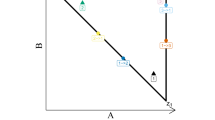Abstract
We develop and implement a collocation method to solve for an equilibrium in the dynamic legislative bargaining game of Duggan and Kalandrakis 2008, unpublished manuscript. We formulate the collocation equations in a quasi-discrete version of the model, and we show that they are locally Lipchitz continuous and directionally differentiable. In numerical experiments, we successfully implement a globally convergent variant of Broyden’s method on a preconditioned version of the collocation equations, and the method economizes on computation cost by more than 50% compared to the value iteration method. We rely on a continuity property of the equilibrium set to obtain increasingly precise approximations of solutions to the continuum model. We showcase these techniques with an illustration of the dynamic core convergence theorem of Duggan and Kalandrakis 2008, unpublished manuscript in a nine-player, two-dimensional model with negative quadratic preferences.
Similar content being viewed by others
References
Acemoglu D, Egorov G, Sonin K (2008) Dynamics and stability of constitutions, coalitions, and clubs. Unpublished manuscript
Armijo L (1966) Minimization of functions having Lipschitz-continuous first patial derivatives. Pac J Math 16: 1–3
Banks J, Duggan J (2000) A bargaining model of collective choice. Am Political Sci Rev 94: 73–88
Banks J, Duggan J (2006) A general bargaining model of legislative policy-making. Q J Political Sci 1: 49–85
Baron D (1996) A dynamic theory of collective goods programs. Am Political Sci Rev 90: 316–330
Baron D, Ferejohn J (1989) Bargaining in legislatures. Am Political Sci Rev 83: 1181–1206
Baron D, Herron M (2003) A dynamic model of multidimensional collective choice. In: Kollman K, Miller J, Page S (eds) Computational models in political economy. MIT Press, Cambridge
Battaglini M, Coate S (2007) Inefficiency in legislative policy-making: a dynamic analysis. Am Econ Rev 97: 118–149
Binmore K (1987) Perfect equilibria in bargaining models. In: Binmore K, Dasgupta P (eds) The economics of bargaining. Basil Blackwell, New York
Broyden CG (1965) A class of methods for solving nonlinear simultaneous equations. Math Comput 19: 577–593
Burkardt J (2007) The sobol quasirandom sequence. http://people.sc.fsu.edu/~burkardt/m_src/sobol/sobol.html
Cho SJ (2005) A dynamic model of parliamentary democracy. Unpublished manuscript
Diermeier D, Fong P (2008) Endogenous limits on proposal power. Unpublished manuscript
Duggan J, Kalandrakis T (2007) Dynamic legislative bargaining. W Allen Wallis Institute Working Paper Series 45
Duggan J, Kalandrakis T (2008) Dynamic legislative policy making. Unpublished manuscript
Duggan J, Kalandrakis T, Manjunath V (2008) Dynamics of the presidential veto: a computational analysis. Math Comput Model 48: 1570–1589
Ip CM, Kyparisis J (1992) Local convergence of quasi-newton methods for b-differentiable equations. Math Program 56: 71–89
Judd KL (1998) Numerical methods in economics. 1. The MIT Press, Cambridge
Kalandrakis T (2004) A three-player dynamic majoritarian bargaining game. J Econ Theory 116: 294–322
Kalandrakis T (2010) Minimum winning coalitions and endogenous status quo. Int J Game Theory 39(4): 617–643
Kelley T (2003) Solving nonlinear equations with Newton’s method. SIAM, Philadelphia
Kuntz L, Scholtes S (1994) Structural analysis of nonsmooth mappings, inverse functions, and metric projections. J Math Anal Appl 188: 346–386
Kuntz L, Scholtes S (1995) Qualitative aspects of the local approximation of a piecewise differentiable function. Nonlinear Anal Theory Methods Appl 25: 197–215
Lasserre JB (1998) Integration on a convex polytope. Proc Am Math Soc 126: 2433–2441
Martinez JM, Qi L (1995) Inexact newton methods for solving nonsmooth equations. J Comput Appl Math 60: 127–145
Mas-Colell A (1985) The theory of general economic equilibrium: a differentiable approach, no. 9, Econometric Society Monographs. Cambridge University Press, Cambridge
Miranda MJ, Fackler PL (2002) Applied computational economics and finance. The MIT Press, Cambridge
Pang JS (1990) Newton’s method for b-differentiable equations. Math Oper Res 15: 311–341
Pang JS (1991) A b-differentiable equation-based, globally and locally quadratically convergent algorithm for nonlinear programs, complementarity and variational inequality problems. Math Program 51: 101–131
Penn EM (2009) A model of farsighted voting. Am J Political Sci 53: 36–54
Plott CR (1967) A notion of equilibrium and its possibility under majority rule. Am Econ Rev 57: 787–806
Press WH, Teukolsky SA, Vetterling WT, Flannery BP (1992) Numerical recipes. In: The art of scientific computing, 2nd edn. Cambridge University Press, Cambridge
Qi L (1993) Convergence analysis of some algorithms for solving nonsmooth equations. Math Oper Res 18: 227–244
Qi L (1997) On superlinear convergence of quasi-newton methods for nonsmooth equations. Oper Res Lett 20: 223–228
Qi L, Sun J (1993) A nonsmooth version of newton’s method. Math Program 58: 353–367
Qi L, Shapiro A, Ling C (2005) Differentiability and semismoothness properties of integral functions and their applications. Math Program Ser A 102: 223–248
Rivlin TJ (1990) Chebyshev polynomials: from approximation theory to algebra and number theory. Wiley Interscience, NewYork
Rubinstein A (1982) Perfect equilibrium in a bargaining model. Econometrica 50: 97–110
Xu H, Chang XW (1997) Approximate newton methods for nonsmooth equations. J Optim Theory Appl 93: 373–394
Author information
Authors and Affiliations
Corresponding author
Rights and permissions
About this article
Cite this article
Duggan, J., Kalandrakis, T. A Newton collocation method for solving dynamic bargaining games. Soc Choice Welf 36, 611–650 (2011). https://doi.org/10.1007/s00355-010-0513-2
Published:
Issue Date:
DOI: https://doi.org/10.1007/s00355-010-0513-2




